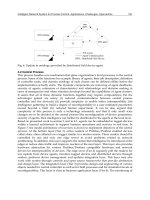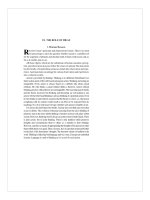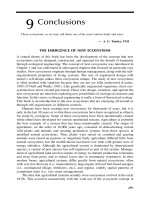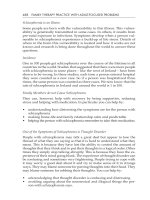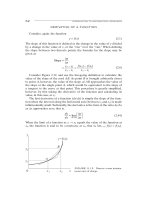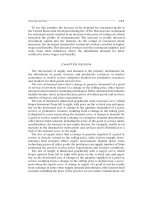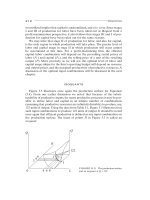Lecture Leadership - Theory and practice: Chapter 9 - Transformational leadership
Bạn đang xem bản rút gọn của tài liệu. Xem và tải ngay bản đầy đủ của tài liệu tại đây (1010.06 KB, 33 trang )
Chapter 9 - Transformational Theory
Leadership
Chapter 9 –
Transformational Leadership
Northouse, 4th edition
Chapter 9 - Transformational Theory
Overview
Transformational Leadership (TL) Perspective
A Model of Transformational Leadership
Transformational Leadership Factors
Full Range of Leadership Model
The Additive Effects of TL
Other Transformational Leadership Perspectives
How Does the Transformational Approach Work?
Chapter 9 - Transformational Theory
Transformational Leadership
Description
Process - TL is a process that:
– changes and transforms individuals
– frequently incorporates charismatic and
visionary leadership
Influence - TL involves an exceptional form
of influence that moves followers to
accomplish more than what is usually
expected of them
Chapter 9 - Transformational Theory
Transformational Leadership
Description
Core elements - TL
– is concerned with emotions, values, ethics, standards,
and long-term goals
– includes assessing followers’ motives, satisfying their
needs, and treating them as full human beings
Encompassing approach – TL
– describes a wide range of leadership influence
Specific: one-to-one with followers
Broad: whole organizations or entire cultures
– follower(s) and leader are inextricably bound together
in the transformation process
Chapter 9 - Transformational Theory
Types of Leadership Defined
James McGregor Burns (1978)
Transformational Leadership
– Emphasized the difference between sources of authority
– includes raising the level of morality in others
Two types of leadership
– Transactional – contractual management
– Transformational (transforming) – “occurs when
one or more persons engage with others in such a
way that leaders and followers raise one another to
higher levels of motivation and morality” (1978)
– Pseudotransformational – personalized
leadership
Chapter 9 - Transformational Theory
Types of Leadership Defined
Burns (1978)
Focuses on the
exchanges
that occur
between leaders
and their
followers
TRANSACTIONAL
Process of
engaging with others
to create a
connection that
increases
motivation and
morality in both the
leader and the
follower
TRANSFORMATIONAL
Focuses on
the
leader’s
own interests
rather than the
interests of
their followers
PSEUDOTRANSFORMATIONAL
Chapter 9 - Transformational Theory
Types of Leadership Defined
Burns (1978)
Focuses on the
exchanges
that occur
between leaders
and their followers
- No new taxes = votes.
- Sell more cars = bonus.
- Turn in assignments =
grade.
- Surpass goals = promotion.
…
The exchange dimension is
so common that you can
observe it at all walks of life.
TRANSACTIONAL
Chapter 9 - Transformational Theory
Types of Leadership Defined
Burns (1978)
Focuses on the
leader’s
own interests
rather than the
interests of their
followers
Leaders who are
– transforming but in a
negative way
– self-consumed,
exploitive, power-oriented,
with warped moral values
includes leaders like
Adolph Hitler
Saddam Hussein
PSEUDOTRANSFORMATIONAL
Chapter 9 - Transformational Theory
Types of Leadership Defined
Burns (1978)
Leader is attentive to the
needs and motives of
followers and tries to help
followers reach their fullest
potential.
Mohandas Gandhi – raised
the hopes and demands of
millions of his people and in
the process was changed
himself
TRANSFORMATIONAL
Process of
engaging with others
to create a connection
that increases
motivation
and morality in both the
leader and the follower
Chapter 9 - Transformational Theory
Types of Leadership Defined
Burns (1978)
Leader is attentive to the needs
and motives of followers and tries to
help followers reach their fullest
potential.
Org. example - A manager attempts
to change his/her company’s
corporate values to reflect a more
humane standard of fairness &
justice – In the process both
manager & followers may emerge
with a stronger & higher set of
moral values
TRANSFORMATIONAL
Process of
engaging with others
to create a connection
that increases
motivation
and morality in both the
leader and the follower
Chapter 9 - Transformational Theory
Transformational Leadership
& Charisma
Definition
Charisma - A special personality characteristic that
gives a person superhuman or exceptional powers and is
reserved for a few, is of divine origin, and results in the
person being treated as a leader (Weber, 1947)
Charismatic Leadership Theory (House, 1976)
– Charismatic leaders act in unique ways that have
specific charismatic effects on their followers
Chapter 9 - Transformational Theory
Theory of Charismatic Leadership
1976)
(House,
Chapter 9 - Transformational Theory
Theory of Charismatic Leadership
(Shamir, House, & Arthur, 1993)
Later Studies
Charismatic Leadership –
– Transforms follower’s self-concepts; tries to link identity
of followers to collective identity of the organization
Forge this link by emphasizing intrinsic rewards &
de-emphasizing extrinsic rewards
Throughout process leaders
• Express high expectations for followers
• help followers gain sense of self-confidence and
self-efficacy
Chapter 9 - Transformational Theory
Model of Transformational Leadership
Bass (1985)
Transformational Leadership Model
– Expanded and refined version of work done by Burns
and House. It included:
More attention to follower’s rather than leaders’ needs
Suggested TL could apply to outcomes that were not
positive
Described transactional and transformational
leadership as a continuum
– Extended House’s work by:
• Giving more attention to emotional elements & origins of
charisma
• Suggested charisma is a necessary but not sufficient
condition for TL
Chapter 9 - Transformational Theory
Model of Transformational Leadership
Bass (1985)
TL motivates followers beyond the expected by:
raising consciousness about the value and importance of
specific and idealized goals
transcending self-interest for the good of the team or
organization
addressing higher-level needs
Chapter 9 - Transformational Theory
Transformational Leadership Factors
Leaders
Leaderswho
whoexhibit
exhibitTL:
TL:
have
haveaastrong
strongset
set of
ofinternal
internalvalues
values&& ideals
ideals
are
areeffective
effectivein
in motivating
motivatingfollowers
followersto
tosupport
support
greater
greatergood
goodover
overself-interest
self-interest
Chapter 9 - Transformational Theory
Full Range of Leadership Model
Chapter 9 - Transformational Theory
Transformational Leadership Factors
The 4 “I”s
Idealized Influence
Charisma
Describes leaders who act as strong role models
for followers
– followers identify with leaders and emulate them
Leader’s have high standards of ethical and
moral conduct
– followers deeply respect & trust L’s
– L’s provide a vision and sense of mission
Chapter 9 - Transformational Theory
Transformational Leadership Factors
The 4 “I”s
Inspirational Motivation
Leaders who communicate high expectations to
followers
– inspiring followers through motivation to commitment
and engagement in shared vision of the organization
– L’s use symbols & emotional appeals to focus group
members to achieve more than self-interest; team
spirit promoted
Chapter 9 - Transformational Theory
Transformational Leadership Factors
The 4 “I”s
Intellectual
Stimulation
Stimulates followers to be creative and
innovative
Challenge their own beliefs and values those
of leader and organization
Leader supports followers to
– try new approaches
– develop innovative ways of dealing with
organization issues
Chapter 9 - Transformational Theory
Transformational Leadership Factors
The 4 “I”s
Individualized Consideration
Leaders who provide a supportive climate
in which they listen carefully to the needs
of followers
Leader’s act as coaches and advisors
encouraging self-actualization
Chapter 9 - Transformational Theory
Transactional Leadership Factors
Transactional Leaders –
Leaders do not individualize the needs of
subordinates nor focus on their personal
development
Exchange things of value with subordinates
to further both’s agendas
Chapter 9 - Transformational Theory
Transactional Leadership Factors
Contingent Reward
The exchange process between leaders and
followers in which effort by followers is exchanged for
specified rewards
Management by Exception
Leadership that involves corrective criticism, negative
feedback, and negative reinforcement
– Two forms
Active - Watches follower closely to identify mistakes/rule
violations
Passive - Intervenes only after standards have not been met
or problems have arisen
Chapter 9 - Transformational Theory
Nonleadership Factor
Laissez-Faire
The absence of leadership
A hands-off, let-things-ride approach
Refers to a leader who
– abdicates responsibility
– delays decisions
– gives no feedback, and
– makes little effort to help followers satisfy their
needs
Chapter 9 - Transformational Theory
Additive Effect of
Transformational Leadership
